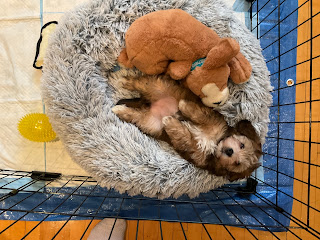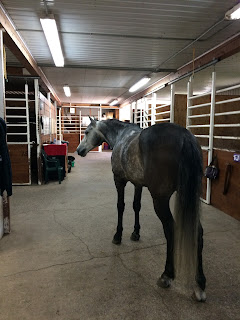Challenging my assumptions, the mounted police way
Some interesting developments on the despooking clinic. Full disclosure, I write this from the comfort of my sofa, with heating pad and anti-inflammatories. My back pain reared its ugly head this week and after three hours of riding and walking, I was d.o.n.e.
Having done obstacle training before I had a certain approach down pat. Introduce obstacle from the ground, ensure the horse respects your space, and reward every try. But do not let the obstacle be ignored. This is not a negotiation. Eventually the confidence builds and each new obstacle becomes easier. But most new obstacles are introduced from the ground.
Here, it was very different.
First the context. A smallish arena (60x120ft) with the back door opened for auditors, housed under a temporary shelter with tarp cover. Hellish gusty wind blowing through the tarp. 11 horses and handlers, most of which were hot, reactive, and lacked training. All of the walls and corners had obstacles, tarps, mattresses, stuffed animals. Bridge and highway cones in the middle. And we had loudspeakers.
There was not a lot of room to maneuver, and the horses were highly reactive and bolting at the backdoor tarp contraption. And as we know, horses influence horses.
While we could stay on the ground for as long as we wanted, everyone got in the saddle from the start. Within an hour, half of us were back on the ground. Fail :-)
We started with drill exercises, but the teacher quickly understood that most of us did not have a strong enough grasp of the aids to do basic nose to heel formations.
So then we resorted to basic circling around the arena while she introduced one obstacle after the other. Plank, blacked out plank, tarp, black and white plank, bridge, mattress. By the time she pulled out the tarp, I was back on the ground.
Even if I followed a good horse super close, my horse would not go near the first plank. While we did reduce our evasion from 5 to 2 feet by the sixth pass, my horse was still very unsure and tense. And when another horse would react and bolt, he (well, both of us) would get anxious,
Turns out, that Ive never introduced him to obstacles for the first time from the saddle. Fail!
What is interesting is that police horses must be confident and courageous when facing new obstacles, at all times. You dont have the option of groundwork during a riot.
Also, you arent supposed to force the horse to do the obstacle. Just keep moving. That just blew my mind. What? Give him a choice? Thats crazy.
So we just kept moving, and circling, and avoiding the obstacles. And then, he stepped on the plank. And the next turn, he added the black plank. And a few turns after that, he added the tarp. It took quite a few more turns before we had most of the obstacles done. But we never conquered the mattress.
It was an interesting experience. Unfortunately with all that walking, my level of irritation and physical discomfort grew and I was no longer receptive to learning. So I quit, went home, and now its just me and the heating pad.
It was also a humbling experience from a teaching/learning perspective. It reminded me of how it feels to be the worst student in the group, and how quick you can shut down when the pressure is too strong.
I will remember how irritated I felt when she kept adding new obstacles while I still hadnt mastered the first ones. Ill be more careful with my own students in the future.
So what did we do well? Surprisingly, Q was very much in control (even if hot and reactive). He listened to my leg for sidepasses to get into formation, we did deep corners to get more room with the horse in front, and the connection was engaged and active. He actually looked beautiful and responsive. And after the 12th pass, he completely forgot how terrorized he was of the tarp contraption at the end.
He was a great partner today. And we have lots of work to do.
Having done obstacle training before I had a certain approach down pat. Introduce obstacle from the ground, ensure the horse respects your space, and reward every try. But do not let the obstacle be ignored. This is not a negotiation. Eventually the confidence builds and each new obstacle becomes easier. But most new obstacles are introduced from the ground.
Here, it was very different.
First the context. A smallish arena (60x120ft) with the back door opened for auditors, housed under a temporary shelter with tarp cover. Hellish gusty wind blowing through the tarp. 11 horses and handlers, most of which were hot, reactive, and lacked training. All of the walls and corners had obstacles, tarps, mattresses, stuffed animals. Bridge and highway cones in the middle. And we had loudspeakers.
There was not a lot of room to maneuver, and the horses were highly reactive and bolting at the backdoor tarp contraption. And as we know, horses influence horses.
While we could stay on the ground for as long as we wanted, everyone got in the saddle from the start. Within an hour, half of us were back on the ground. Fail :-)
We started with drill exercises, but the teacher quickly understood that most of us did not have a strong enough grasp of the aids to do basic nose to heel formations.
So then we resorted to basic circling around the arena while she introduced one obstacle after the other. Plank, blacked out plank, tarp, black and white plank, bridge, mattress. By the time she pulled out the tarp, I was back on the ground.
Even if I followed a good horse super close, my horse would not go near the first plank. While we did reduce our evasion from 5 to 2 feet by the sixth pass, my horse was still very unsure and tense. And when another horse would react and bolt, he (well, both of us) would get anxious,
Turns out, that Ive never introduced him to obstacles for the first time from the saddle. Fail!
What is interesting is that police horses must be confident and courageous when facing new obstacles, at all times. You dont have the option of groundwork during a riot.
Also, you arent supposed to force the horse to do the obstacle. Just keep moving. That just blew my mind. What? Give him a choice? Thats crazy.
So we just kept moving, and circling, and avoiding the obstacles. And then, he stepped on the plank. And the next turn, he added the black plank. And a few turns after that, he added the tarp. It took quite a few more turns before we had most of the obstacles done. But we never conquered the mattress.
It was an interesting experience. Unfortunately with all that walking, my level of irritation and physical discomfort grew and I was no longer receptive to learning. So I quit, went home, and now its just me and the heating pad.
It was also a humbling experience from a teaching/learning perspective. It reminded me of how it feels to be the worst student in the group, and how quick you can shut down when the pressure is too strong.
I will remember how irritated I felt when she kept adding new obstacles while I still hadnt mastered the first ones. Ill be more careful with my own students in the future.
So what did we do well? Surprisingly, Q was very much in control (even if hot and reactive). He listened to my leg for sidepasses to get into formation, we did deep corners to get more room with the horse in front, and the connection was engaged and active. He actually looked beautiful and responsive. And after the 12th pass, he completely forgot how terrorized he was of the tarp contraption at the end.
He was a great partner today. And we have lots of work to do.





I have such mixed feelings on the police-style despooking clinics. I used to train horses for the Newark mounted PD (and thereby some of the Philly police horses were trained by me!) and while it's true that the horses have to be good under pressure, you can bet your bottom we did a lot of ground work and introducing things NOT in the saddle before they ever became police horses. I like the police clinics they have around here for testing horses who have already done some despooking work (and I have students whose horses have been praised by the clinician many times over the years for how well they do). With that said, I don't think I like them as a way to "despook" horses who are hot or reactive. There's too much going on and too many outside variables that you can't control to give your horse a positive experience. If you're in a herd of good horses who are being calm, the follow the leader technique can be effective on one nervous horse, but as you mentioned, horses feed off of each other so if you have a nervous bunch, things can so easily spiral out of control. Of course, YMMV, but those are my thoughts, and I found your write up very interesting. It's so awesome that Q was under control even while he was "up". What a testament to your relationship leading up to this. I also like your takeaways for your own students :)
ReplyDeleteDom, Thank you for being the first to comment on my blog! Your insights are on point and reflect my own philosophies quite well. I just love your blog and relish your training entries.
DeleteI returned today to see the Day 2 of the clinic (but from the safe and comfortable sidelines) and it does continue to make me pause on my own assumptions. Ill finish a write-up on the additional insight with some media.
Hi! New reader :) I've done a couple of the mounted police clinics. They set it up here so that everyone had a confident buddy and everything was done in team withthat buddy, side by side where possible. I liked that approach. It sounds like your guy has a great brain! I'm looking forward to following your blog :)
ReplyDeleteWelcome T! New blogger here ;-) I enjoy your raincoast rider blog with the adventures of Sophie and Bridget. I can't wait until you start backing the pretty banana pony. Thanks for commenting.
DeleteAt the start, I quickly identified a good buddy and covered her like glue. Her poor gelding's bum was covered with my Q's saliva. Once, he even threw us a dirty look.
That said, I think I just needed more hours and more repetition. The plight of the sensitive horse. Not complaining though, because I truly appreciate the sensitive cautious thinking horses best.